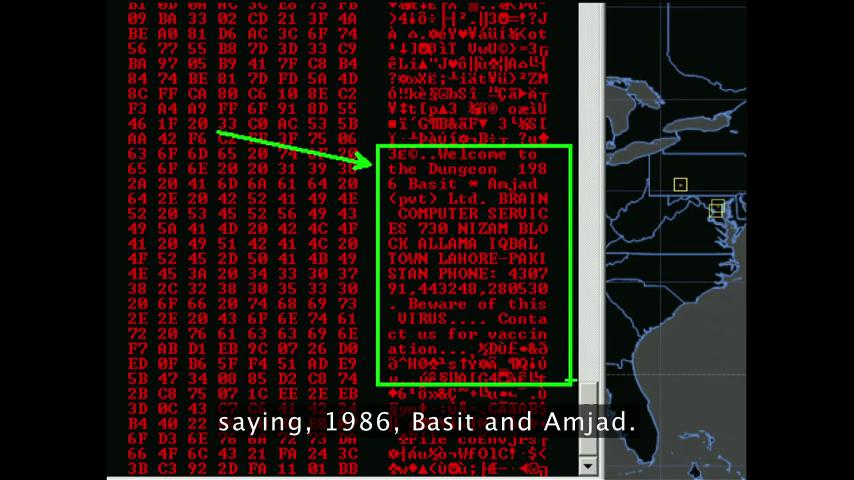Year 1986: The Birth Of The Pakistani Brain Virus

Introduction
The 1980s were an era of technological revolution. Computers had become the hottest new trend, captivating the minds of enthusiasts worldwide. Amid this backdrop of innovation, people eagerly experimented with the latest technology, pushing the boundaries of what was possible. Our story today takes us to Pakistan in the mid-1980s. A time where two brothers accidentally create a digital phenomenon called the “Pakistani Brain Virus” that becomes the first computer virus for the MS-DOS system. Let’s dive into this fascinating tale!
Creating the Pakistani Brain Virus
Two teenagers, who also happened to be brothers, wrote the Pakistani Brain Virus. The brother duo was Basit and Amjad Farooq Alvi. The brothers were self-taught programmers and ran a computer store in Lahore, Pakistan. While the world was still getting accustomed to computers, the brothers started a company called “Brain Computer Services.” The main service of this company was writing and selling basic software for computers. The mastermind behind the company, Amjad Farooq Alvi, was a big-time computer enthusiast.

The 1980s were a time when programmes on computers ran on floppy disks. The operating system was MS-DOS and in their quest to explore the software, they discovered a flaw in it. The flaw was that it did not provide any copyright protection. Now, like any other computer-savvy person, they did not want people to just copy their software without paying for it. Concerned about people copying their software without paying for it, the brothers decided to take action.
Determined to protect their intellectual property, Basit and Amjad wrote a small piece of code that would prevent unauthorized copying. They named this code “Brain”. The brothers designed the virus to save the serial numbers of all computers that copied the software, effectively tracking unauthorized copies. Additionally, it slowed down the operation of infected floppy disks, discouraging further copying.
The Mechanics of the Pakistani Brain Virus
The “Brain Virus” was a boot sector virus. This type of virus specifically targeted the boot sector of floppy disks, an essential area read by a computer’s Basic Input/Output System (BIOS) during startup. Understanding how the Brain Virus operated sheds light on its widespread impact.
Here’s how the Brain Virus operated:
Infection of the Boot Sector:
The boot sector of a floppy disk is a crucial segment that the BIOS reads when a computer starts up. The Brain Virus embedded itself in this sector, ensuring it was executed whenever an infected disk was used to boot a computer.
Spreading the Virus:
Users unknowingly spread the virus by booting their computers from infected floppy disks. Once the virus was active in the system’s memory, any subsequent floppy disks used in that computer would become infected, propagating the virus further.
Impact on Systems:
The Brain Virus did not aim to destroy data. However, it caused several issues, including:
System Performance: Infected systems experienced slower performance.
Tracking Copies: The virus recorded the serial numbers of computers that copied the infected software.
Disk Operation: It significantly slowed down the operation of infected floppy disks.
The primary purpose of the Brain Virus was not malicious. Basit and Amjad Farooq Alvi designed the virus to protect their heart-monitoring software from being copied without permission. This software was being used in a small hospital in Pakistan, and the brothers wanted to ensure its integrity and prevent unauthorized distribution.
However, despite their intentions, the Alvi brothers were taken by surprise when their protective measure had unintended global consequences. One day, they received a call from a student at Miami University, Florida, who had discovered the “Brain Virus” on her floppy disk. This unexpected call highlighted how far and wide their virus had spread, well beyond their local environment in Pakistan.
The Spread of the Brain Virus
The Brain Virus was a low-level computer virus with an extremely simple design, yet it excelled at propagating itself. Once the Pakistani Brain virus infected a computer, it became memory-resident, meaning it would load into the computer’s memory and remain active as long as the system was running. The virus would intercept any attempt to access the boot sector, ensuring that it could spread to any new disks used on the infected computer. This method of propagation allowed the virus to quietly and efficiently spread from one system to another.
The virus was also able to hide itself from any detection by antivirus software. This made the virus one of the early examples of a “stealth” virus.
The Alvi brothers gained worldwide fame for their innovation, partly due to the message embedded in their virus. This message included their names, address, and phone numbers, providing contact information for those seeking to remove the virus. The message read:
“Welcome to the Dungeon (c) 1986 Basit & Amjads (pvt) Ltd VIRUS_SHOE RECORD V9.0 Dedicated to the dynamic memories of millions of viruses who are no longer with us today – Thanks GOODNESS!! BEWARE OF THE er..VIRUS : this program is catching program follows after these messages….$#@%$@!!
Welcome to the Dungeon © 1986 Basit & Amjads (pvt). BRAIN COMPUTER SERVICES 730 NIZAM BLOCK ALLAMA IQBAL TOWN LAHORE-PAKISTAN PHONE: 430791, 443284, 280530. Beware of this VIRUS…. Contact us for vaccination…”

The Alvi brothers gained recognition for their novel virus, receiving calls from around the world—some seeking to “vaccinate” their PCs, others driven by curiosity. Their story caught the attention of TIME Magazine, which featured them in a 1988 article titled “Technology: You Must Be Punished.” The article both celebrated and criticized their innovation.
A “Friendly” Virus
As per Alvi brother, Brain was a “friendly” virus which did not intend to harm anyone, rather it was a form of protection for them. To stop the virus from spreading, the brothers also developed an antivirus software. They have even claimed that their innovation is an inspiration to many viruses and even antivirus software.
That being said, today the “Brain Virus” is an important part of the history of cybersecurity. Its creation and spread highlight the security risks of software piracy. Taking precautions and keeping security systems updated are essential to prevent and lessen the impact of such viruses. Stay alert and use strong cybersecurity practices to protect your systems against new threats!









